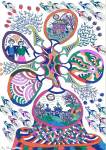‘Outsider Art’ is gaining prominence in the UK, but it’s been a slow awakening. Rather than breaking new territory, Britain is catching up with the rest of Europe and the USA, where there is a developed understanding of the history and value of Outsider Art.
This year, I was invited to join the European Outsider Art Association Committee and attended their recent conference in Paris at Halle Saint Pierre. Halle Saint Pierre is a venue well known for exhibiting Outsider Art: its current show is dedicated to Raw Vision Magazine’s 25th anniversary. The exhibition is a unique gathering of international art representing the diversity and vision of the UK-based magazine. It includes some of the greats of Outsider Art: Henry Darger, Adolf Wölfli, Madge Gill and Aloïse Corbaz, among others. There is no comparable venue in London or England regularly programming Outsider and non-traditional art.
At the conference there was a particularly strong debate about the curation of Outsider Art that referenced and compared the ideas of the curator Harald Szeemann and the artist Jean Dubuffet. Szeemann curated exhibitions with a strong thematic focus, drawing on artists from a range of backgrounds including Outsider Artists, whereas Dubuffet argued for the clear demarcation and separate display of Outsider Art, worried that merging the two categories (Outsider and fine art) would muddy the waters and somehow devalue both.
It was good to hear such an interesting and complex discussion, which did not simply argue the case for Outsider Art’s inclusion – as is often the case in the UK – but also looked at how to curate and display the work to its best advantage.
In Europe Outsider Art is extremely well established, having many dedicated museums and galleries. Audiences, curators and galleries are more comfortable looking at and programming unconventional work. The Lille Métropole Museum of Modern, Contemporary and Outsider Art (LaM) is an interesting example of a museum that has chosen to follow Dubuffet’s model and display their Outsider Art collection as a distinct, but equal, group alongside their historic and contemporary exhibitions.
Despite the apparent open-mindedness of Europe and the USA to Outsider Art, there is still a sense of two worlds colliding rather than merging. We are living in time of flux, where it is as fair to challenge conventional aesthetics and cultural values as it is to question art and its particular purpose. A wider understanding of creativity does not necessarily lead to dumbing down, though I often hear this suggested either openly or in the subtext of conversations. This opening out of culture will enable people to once again trust their innate aesthetic sense of what they like and what communicates to them. I am sure there will be no turning back, but rather a period of assimilation, evolution and perhaps even the development of a new methodology to capture and describe art.
Marc Steene is Executive Director at Pallant House Gallery, Chichester. The gallery’s flagship project, ‘Outside In’, is a platform for artists who find it hard to access the art world; it sidesteps the need to label artists by allowing them to decide for themselves how they are described. It has helped 2000 artists exhibit their work online and at galleries across the UK.






